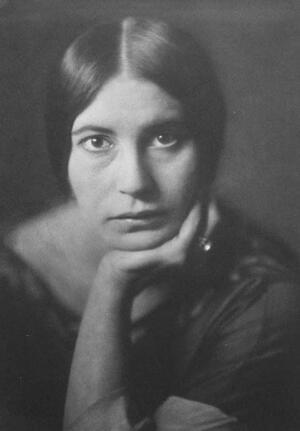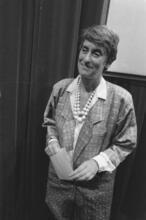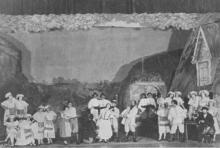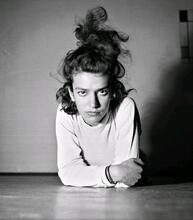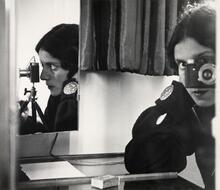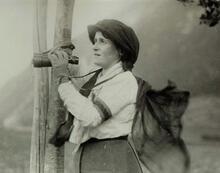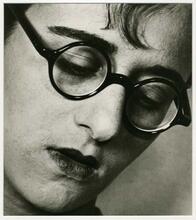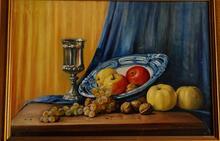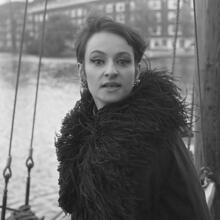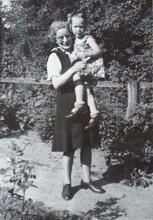Nini Hess
In the years between 1914 and 1933, numerous significant personalities in art, culture, politics, society and sport met in the photographic portraiture studio of Nini and Carry Hess. With their technical and aesthetic brilliance, the sisters were among the leading photographers in Germany of the time. Their long collaboration with Frankfurt theaters resulted in the portraits of numerous actors, both in the roles they played and in their person. The Hesses were compelled to terminate their collaboration with the theaters in 1933. The Nazis destroyed the Hess studio, including all its technical equipment and the archives of negatives. Carry fled to the South of France, where she survived the war in hiding. Nini was deported and murdered in Auschwitz in 1942.
Photography Work
In the years between 1914 and 1933 numerous significant personalities in art, culture, politics, society and sport met in the photographic portraiture studio of Nini and Carry Hess. With their technical and aesthetic brilliance, the sisters were among the leading photographers in Germany of the time. In the 1920s their photographs essentially stamped the image of Woman. Their long collaboration with the Städtischen Bühnen Frankfurt (Frankfurt city theaters) resulted in the portraits of numerous actors, both in the roles they played and in their own person. These included Albert Bassermann (1867–1952), Elisabeth Bergner, Carl Ebert (1887–1980), Heinrich George (1893–1946), Paul Graetz (1890–1938), Gerda Müller (1895–1951), Leontine Sagan (1889–1974); the composers Paul Hindemith (1885–1963) and Leos Janacek (1854–1928), and the authors Thomas Mann (1875–1955), Fritz von Unruh (1885–1970) and Carl Zuckmayer (1896–1977).
The blossoming of their studio coincided with the major development phase of both photography and theater; the genesis of their pictorial “language” was influenced not only by epoch-making theatrical innovations in the form of Expressionism and Constructivism, but also by complex movements in photography, such as art photography, straight photography and Neue Sachlichkeit. Nini and Carry Hess perceived modern art as a productive challenge, but not as an authority to which they had to submit. Professional photographers combining craftsmanship, artistic craft and fine art, the focus of their portraits was always on the characterization which expressed itself in the face of the individual subjects of their works.
Stefanie Hess was born in Frankfurt am Main on August 21, 1884, the daughter of Samuel Hess (1848–1924), a businessman, and Lina Hess (née Salomon, 1859–1942). Her sister Cornelia was born five years later, on November 11, 1889. Nicknamed Nini and Carry, the sisters grew up in a well-to-do liberal Jewish house, which ensured a sound education for both daughters. Nothing is known about their professional training. In 1912 Carry Hess was awarded a prize for professional photography in the category of Art Photography at the General German Photography Exhibition in Heidelberg. Assisted by their family’s social status, Nini and Carry Hess founded their joint portrait photography studio in the Sigmund Strauss House at 2–4 Börsenstrasse (formerly the Theaterplatz, now Rathenauplatz), which existed until 1938. The family’s encouragement not only furthered business in their workplace located in such a superior neighborhood, but was also of the greatest importance in developing a distinguished clientele. The portraits that appeared from 1914 on in the renowned photographic professional journal Das Atelier des Photographen (The Photographers’ Studio) displayed the contribution of the sisters’ characteristic ability, their superb technical skill and their fastidious artistry. Despite their candid use of dramatic lighting effects and a certain tendency to fashionable mannerism, their early portraits are among the precursors of the modern conception of portraiture. From 1920 to 1932 Nini and Carry Hess belonged to the Society of German Photographers (GDL), founded in 1919 by the famous portraitist, Hugo Erfuth.
Collaboration with Frankfurt Stage and Later Work
A major factor in the enduring establishment of the studio was the intensive collaboration, from 1918 until 1933, with the Frankfurt stage, which at the time was, together with Berlin, one of the most progressive theater centers in Germany. Inspired by a profound interest in the theater and enjoying the privilege of numerous personal contacts, Nini and Carry Hess worked continuously at their photographic idiom to make it part of a photographic version of a major avant-garde tendency. Their expressive chiaroscuro photographs of scenes from plays and role-portraits belong to this creative period of Frankfurt Expressionism. The same period also saw the creation of dance studies—composed of light, line and movement—of the major exponents of Expressionist dance (Gret Palucca [1902–1993] and Mary Wigman [1886–1973]); the Constructivist-inspired role portraits of the Moscow Chamber Theater (1925) and the Habimah Ensemble (1927); and their close-grained, New Expressionist stage reportage of important productions and significant open-air theater performances (Heidelberg Castle Theater Festival, Frankfurt-Römerberg Theater Festival).
Many of their portraits, dance studies, stage photos and reportages were published in contemporary newspapers (Frankfurter Illustrierte Zeitung, Südwestdeutsche Rundfunkzeitung, Berliner Illustrierte Zeitung), illustrated magazines (UHU—Ullsteins Illustrierte Monatshefte, Die Dame, Atlantis, Scherls Magazin), periodicals (Das Theater, Der Tanz) and photographic publications (Das deutsche Lichtbild, Das Atelier des Photographen), as well as in illustrated books dealing with the “New Woman” of the 1920s and with the history of dance and theater.
World War II
Like many of the artists working in the field of Frankfurt theater, Nini and Carry Hess were compelled to terminate their collaboration with the theaters in 1933. Carry’s attempt to develop a new professional life in Paris proved a failure. In the winter of 1938–1939, after the SA (the Nazi Sturmabteilung; Storm Troopers) destroyed the studio, including all its technical equipment and the archives of negatives on November 10, 1938, she fled to the South of France, where she survived the war in hiding. In 1942 Nini Hess was deported and murdered in Auschwitz. After World War II Carry Hess returned to Paris, but was unable to resume work because she was blind in one eye. In 1957 she received reparations and a pension from the authorities in Wiesbaden (Germany). She died in Chur on August 17, 1957, while on vacation in Switzerland. Only a few of the original photographs taken by Nini and Carry Hess survived the Nazi period in private collections, museums and archives.

